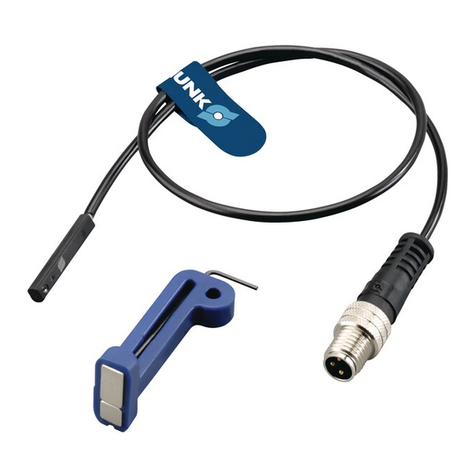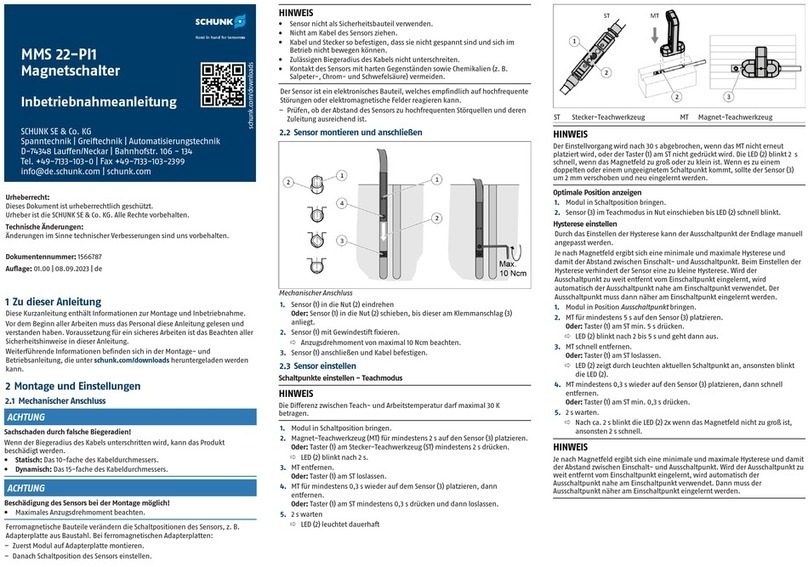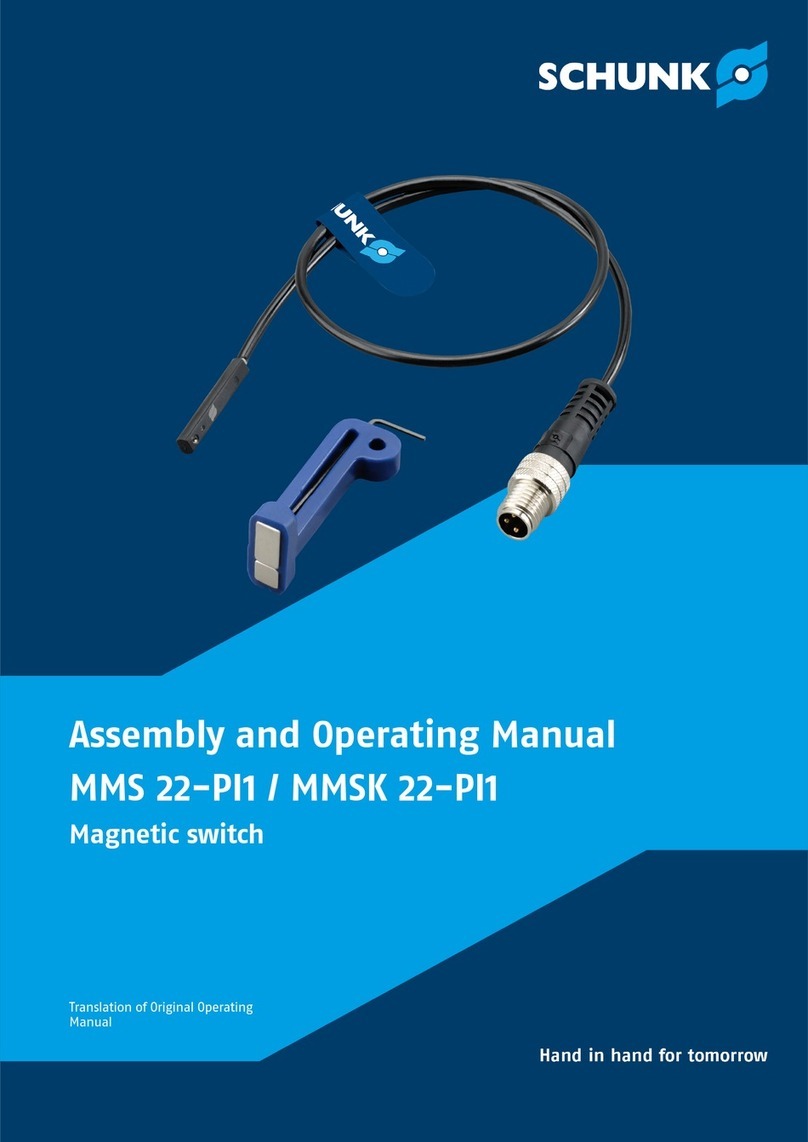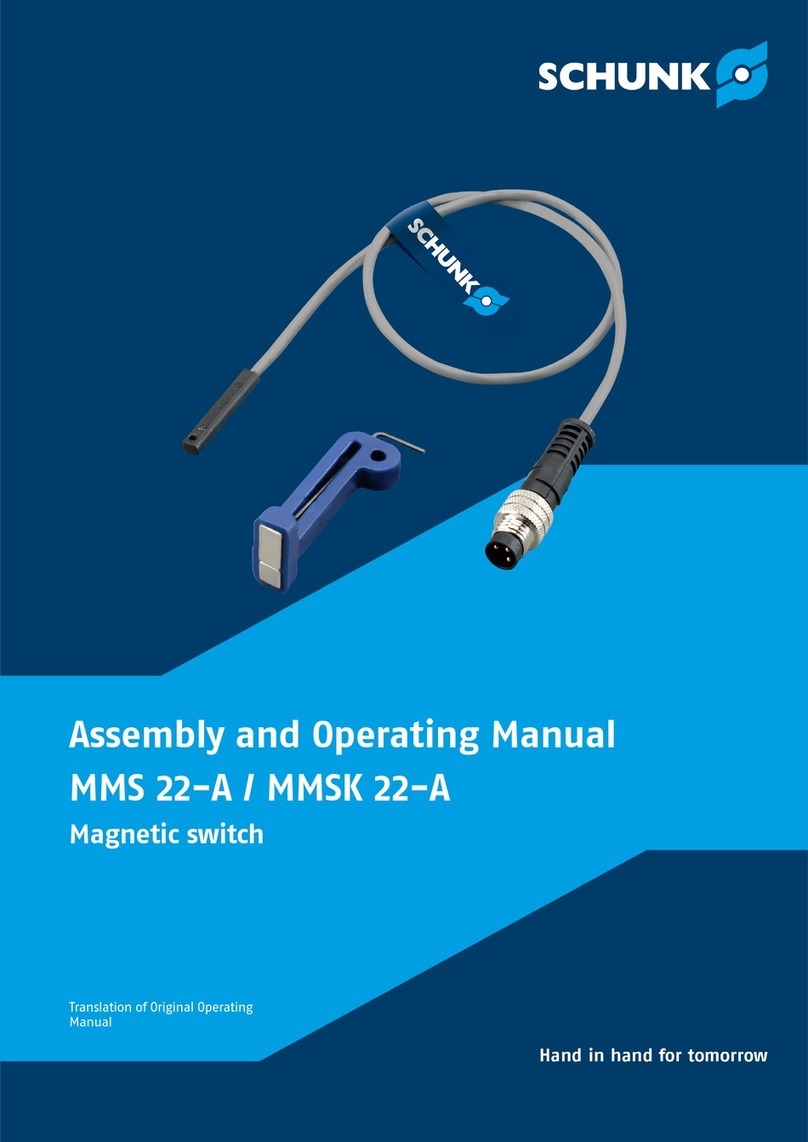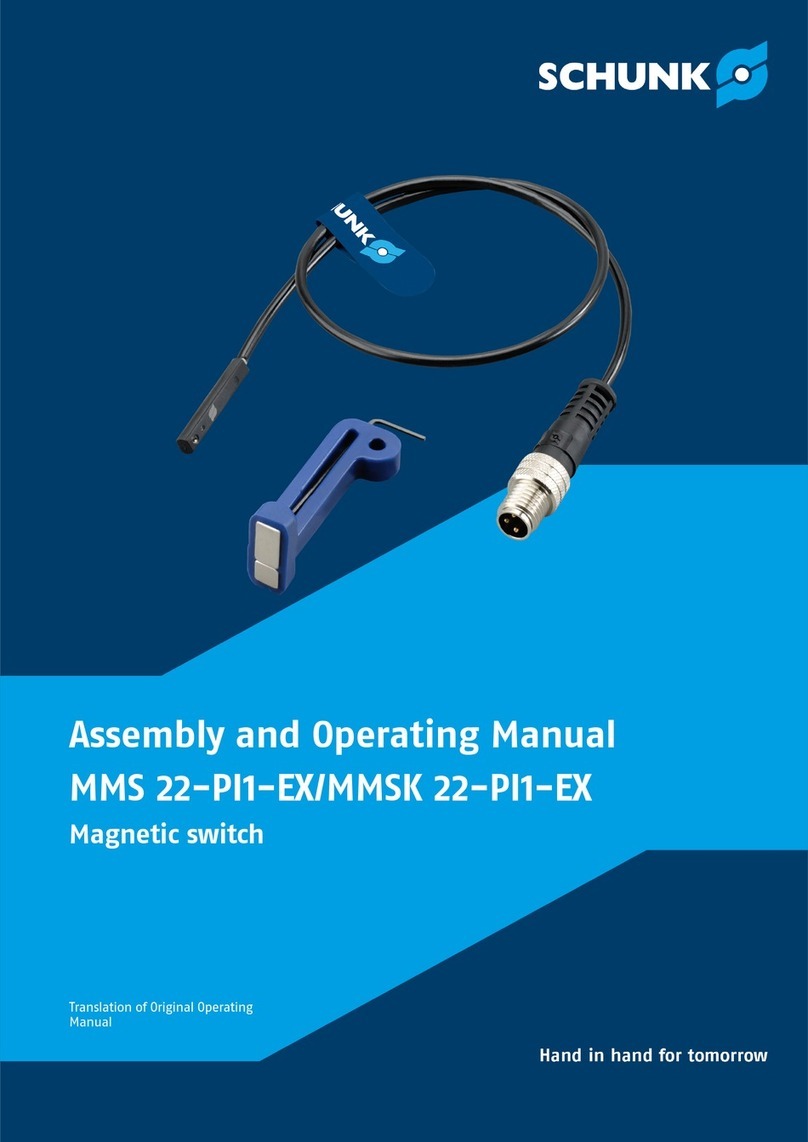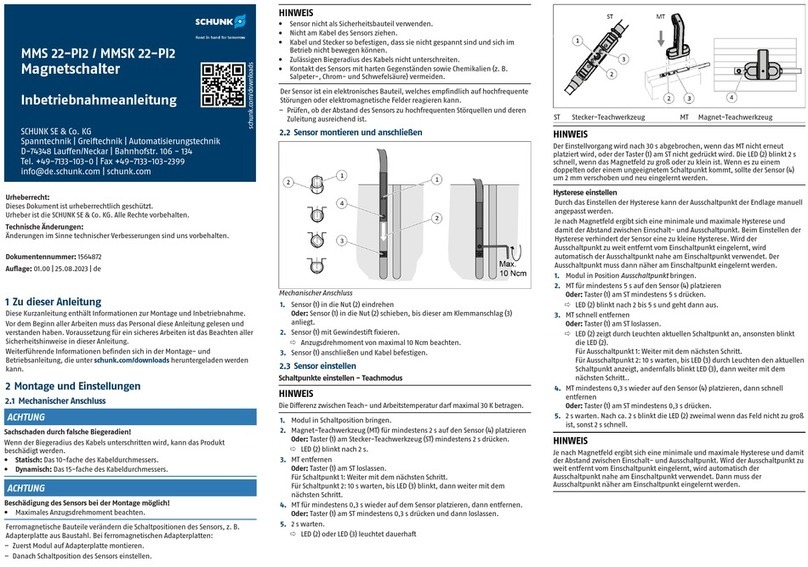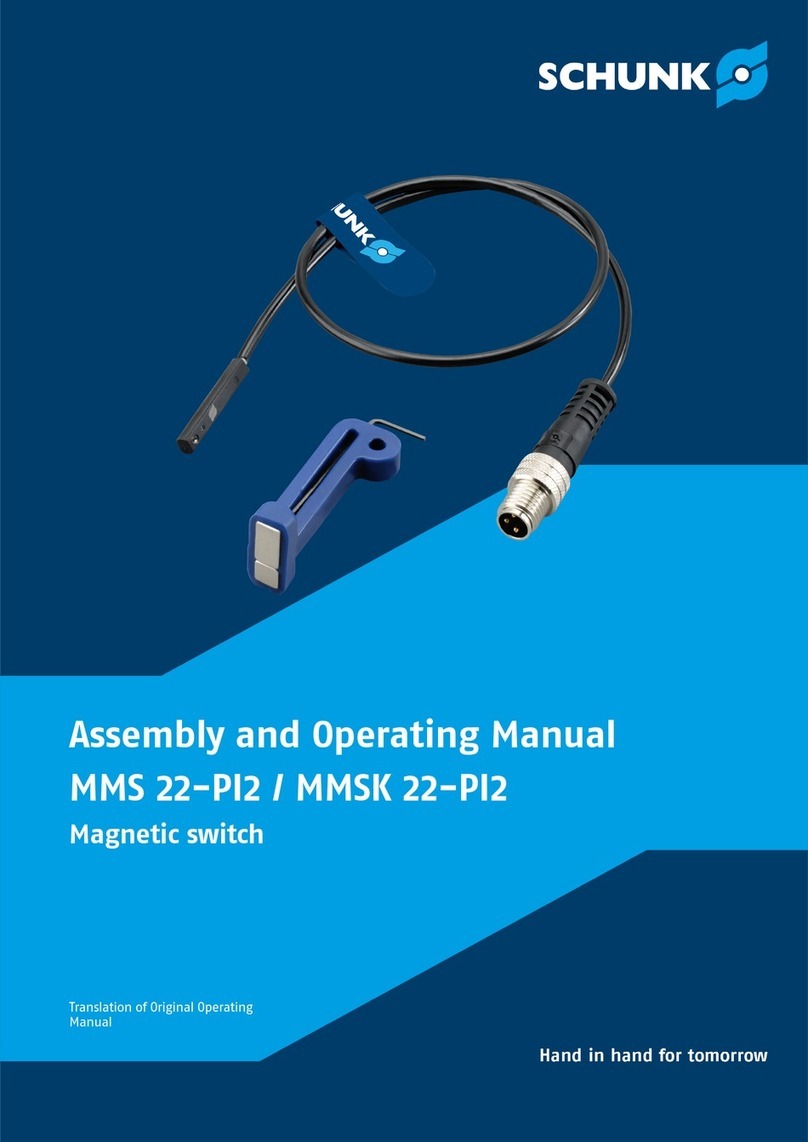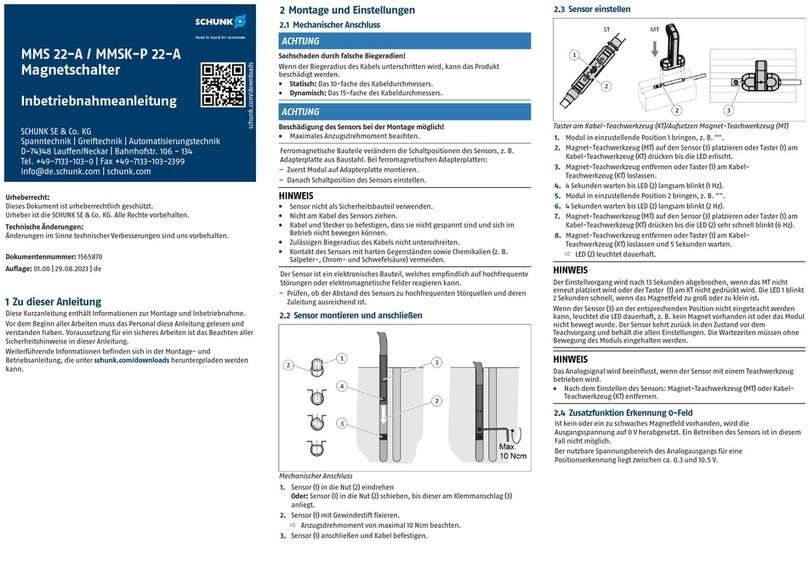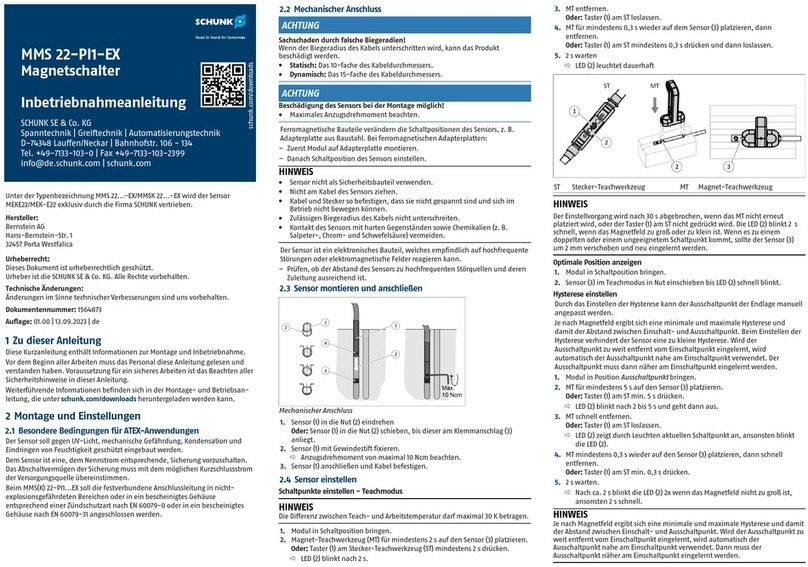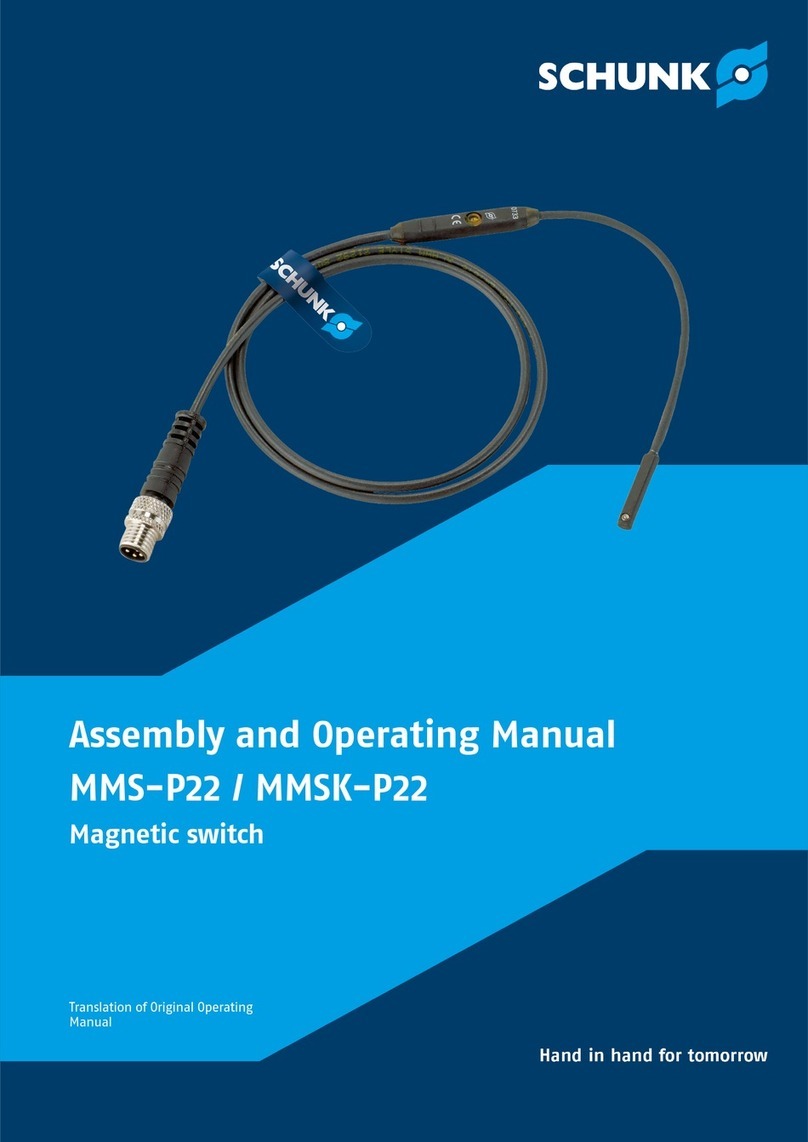
schunk.com/downloads
MMS-P 22 / MMSK-P 22
Magnetschalter
Inbetriebnahmeanleitung
SCHUNK SE & Co. KG
Spanntechnik | Greiftechnik | Automatisierungstechnik
D-74348 Lauffen/Neckar | Bahnhofstr. 106 - 134
Tel. +49-7133-103-0 | Fax +49-7133-103-2399
info@de.schunk.com | schunk.com
Urheberrecht:
Dieses Dokument ist urheberrechtlich geschützt.
Urheber ist die SCHUNKSE&Co.KG. Alle Rechte vorbehalten.
Technische Änderungen:
Änderungen im Sinne technischer Verbesserungen sind uns vorbehalten.
Dokumentennummer: 1565874
Auflage: 01.00|29.08.2023|de
1 Zu dieser Anleitung
Diese Kurzanleitung enthält Informationen zur Montage und Inbetriebnahme.
Vor dem Beginn aller Arbeiten muss das Personal diese Anleitung gelesen und
verstanden haben. Voraussetzung für ein sicheres Arbeiten ist das Beachten aller
Sicherheitshinweise in dieser Anleitung.
Weiterführende Informationen befinden sich in der Montage- und
Betriebsanleitung, die unter schunk.com/downloads heruntergeladen werden
kann.
2 Montage und Einstellungen
2.1 Mechanischer Anschluss
ACHTUNG
Sachschaden durch falsche Biegeradien!
Wenn der Biegeradius des Kabels unterschritten wird, kann das Produkt
beschädigt werden.
lStatisch: Das 10-fache des Kabeldurchmessers.
lDynamisch: Das 15-fache des Kabeldurchmessers.
ACHTUNG
Beschädigung des Sensors bei der Montage möglich!
lMaximales Anzugsdrehmoment beachten.
Ferromagnetische Bauteile verändern die Schaltpositionen des Sensors, z.B.
Adapterplatte aus Baustahl. Bei ferromagnetischen Adapterplatten:
– Zuerst Modul auf Adapterplatte montieren.
– Danach Schaltposition des Sensors einstellen.
HINWEIS
lSensor nicht als Sicherheitsbauteil verwenden.
lNicht am Kabel des Sensors ziehen.
lKabel und Stecker so befestigen, dass sie nicht gespannt sind und sich im
Betrieb nicht bewegen können.
lZulässigen Biegeradius des Kabels nicht unterschreiten.
lKontakt des Sensors mit harten Gegenständen sowie Chemikalien (z.B.
Salpeter-, Chrom- und Schwefelsäure) vermeiden.
Der Sensor ist ein elektronisches Bauteil, welches empfindlich auf hochfrequente
Störungen oder elektromagnetische Felder reagieren kann.
– Prüfen, ob der Abstand des Sensors zu hochfrequenten Störquellen und deren
Zuleitung ausreichend ist.
2.2 Sensor montieren und anschließen
Mechanischer Anschluss
1. Sensor (1) in die Nut (2) eindrehen,
Oder: Sensor (1) in die Nut (2) schieben, bis dieser am Klemmanschlag (3)
anliegt.
2. Sensor (1) mit Gewindestift fixieren.
ðAnzugsdrehmoment von maximal 10Ncm beachten.
3. Sensor (1) anschließen und Kabel befestigen.
4. Elektronik mit Kabelbindern fixieren, um das Kabel zu entlasten.
ðFür die Fixierung die Rippen auf der Elektronik verwenden.
2.3 Sensor einstellen
2.3.1 Schaltpunkte einstellen - Teachmodus
HINWEIS
Die Differenz zwischen Teach- und Arbeitstemperatur darf maximal 30 K
betragen.
HINWEIS
Nach dem die Schaltpunkte eingestellt wurden, darf das Umfeld des Sensors nicht
mehr verändert werden.
1. Modul in Stellung Ausschaltpunkt für Schaltpunkt 1 bringen.
2. Teach-Knopf (2) 2s lang gedrückt halten.
ðLED 1 (1) blinkt nach 2s.
3. Teach-Knopf (2) kurz drücken.
ðLED 1 (1) leuchtet, wenn der Schaltpunkt eingelernt ist.
ðLED 2 (3) blinkt.
4. Modul in Stellung Ausschaltpunkt für Schaltpunkt 2 bringen.
ðLED 1 (1) geht aus, sobald mit dem Modul der Ausschaltpunkt für
Schaltpunkt 1 verlassen wird.
ðLED 2 (3) blinkt.
5. Teach-Knopf (2) kurz drücken.
ðLED 2 (3) leuchtet, wenn der Schaltpunkt eingelernt ist.
2.3.2 Hysterese einstellen
Durch das Einstellen der Hysterese kann der Ausschaltpunkt der Endlage manuell
angepasst werden.
Je nach Magnetfeld ergibt sich eine minimale und maximale Hysterese und
damit der Abstand zwischen Einschalt- und Ausschaltpunkt. Beim Einstellen der
Hysterese verhindert der Sensor eine zu kleine Hysterese. Wird der
Ausschaltpunkt zu weit entfernt vom Einschaltpunkt eingelernt, wird
automatisch der Ausschaltpunkt nahe am Einschaltpunkt verwendet. Der
Ausschaltpunkt muss dann näher am Einschaltpunkt eingelernt werden.
1. Teach-Knopf (2) 5s lang drücken.
ðLED 1 (1) blinkt von Sekunde 2 bis 5
ðLED 1 geht nach 5s aus.
2. Teach-Knopf (2) loslassen.
3. Modul in Stellung Ausschaltpunkt für Schaltpunkt 1 bringen.
4. Teach-Knopf (2) kurz drücken.
ðLED 1 (1) blinkt 2x.
5. Modul in Stellung Ausschaltpunkt für Schaltpunkt 2 bringen.
6. Teach-Knopf (2) kurz drücken.
ðLED 2 (3) blinkt 2x.
